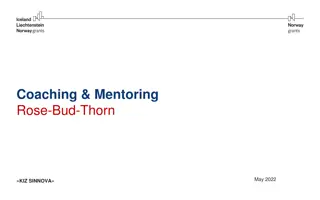Analyzing "A Red, Red Rose" by Robert Burns: Love, Immortality, and Symbolism
In this analysis, we delve into Robert Burns' poem "A Red, Red Rose," exploring the theme of everlasting love and the speaker's expressive portrayal of his beloved through vivid imagery. The poem symbolizes the enduring nature of true love, contrasting it with the transience of youth and beauty. By examining the main ideas, biography of Robert Burns, and dissecting the verses stanza by stanza, we uncover the depth of emotions and the poetic techniques employed by the renowned Scottish poet.
Download Presentation

Please find below an Image/Link to download the presentation.
The content on the website is provided AS IS for your information and personal use only. It may not be sold, licensed, or shared on other websites without obtaining consent from the author. Download presentation by click this link. If you encounter any issues during the download, it is possible that the publisher has removed the file from their server.
E N D
Presentation Transcript
BRITISH LITERATURE Lecturer: Cam Lien, M.A Email: camlien0104@gmail.com Phone: 0947320041
A Red, Red Rose -Robert Burns- The Power of Long-lasting Love
Discuss in group 1. The Biography of Robert Burns (main ideas) 2. Analyze the poem A Red Red Rose by Robert Burns + Summary of the peom + Theme + Meaning of each stanza + Figures of speech (Figurative Language)
Robert Burns 1759-1796
A Red, Red Rose The speaker describes his beloved with images that are beautiful, fresh, and charming as a flower that has just bloomed. The love is as sweet as a beautiful song. Then, the speaker goes on to emphasize how long this love will last. Here, the speaker uses three images to measure these feelings of love. According to him, it will last till the seas and oceans go dry, till the rocks melt. His love will endure until the end of human life. He concludes by saying goodbye to his beloved as if he is planning to leave on a journey. His beloved doesn t need to worry because the speaker promises to return even if the journey covers a very long distance or takes a very long time.
Theme The immortality of the bond of love. the speaker focuses on pure love or spiritual love that never fades with time whereas youth and beauty end with time and its temporary attraction
Meaning of each Stanza Stanza 1: In this stanza the speaker tells his beloved how beautiful she is. She is like a fresh red rose. Red rose is the symbol of love and romance. It represents true love. Then he compares her with nicely played melody. Here he has used two similes --- the first, comparing his love to a rose, and second, comparing her to a sweet melody. Here we find a sincere praise of the poet for his beloved's appearance and temperament.
Stanza 2: In this stanza, the speaker addresses the young lady is pretty.He also confesses his sincere feelings for the girl. He will love her till infinite. He will love her till all the seas go dry. In the last line of the stanza he uses hyperbole. It is a figure of speech that exaggerates. Seas going dry is a hyperbole
Stanza 3: As in the second stanza, in this stanza the speaker also says how much he loves her. He will continue to love her till the rocks melt by the heat of the sun. This also shows his eternal love for her. He also says that his love will continue while 'the sands of life shall run'. This means till the end of his life.
Stanza 4: In this stanza, he says that although he has to leave her for a while, he will certainly return to her, even if he has to take a long journey (ten thousand miles). In other words, he promises to love her how far he might go.
Figures of speech Simile Simile is used to compare an object/person with something else to make meanings clear. The comparing word 'like' or as is used in a simile O, my Luve s like a red, red rose O, my Luve s like the melodie As fair art thou, my bonie lass =Comparison
Hyperbole: Making exaggerated statements or claims not meant to be taken literally Till all the seas go dry And the rocks melt with the sun And I will come again, my luve, Though it were ten thousand mile.
Metaphor While the sands o' life shall run While the sands of life shall run sands of life: the time of his life
Symbolism: Red rose stands for love and romance.
Imagery: description using any of the five senses of sight, sound, taste, touch, and smell. "O my luve s like a red, red rose O, my luve's like the melodie Till a' the seas gang dry "And the rocks melt wi' the sun! "While the sands o' life shall run."
Enjambment: refers to the continuation of a sentence without the pause beyond the end of a line, couplet or stanza such as: O my Luve is like the melody That s sweetly played in tune.
Alliteration: It is the repetition of initial consonant sounds in the same line. Here alliteration is in the following line: "O my love is like a red red rose" /l/ sound is repeated in 'love' and 'like' , and /r/ sound is repeated in 'red red rose .
Assonance It is the repetition of vowel sounds in the same line. In this poem we find assonance in: "I will love thee still, my dear". Here /i/ sound is repeated in 'will' and 'still'.
Consonance: the repetition of consonants (or consonant patterns) especially at the ends of words. That s sweetly played in tune t, t, l, l, n, t, n And fare thee weel a while! w, l, w, l
Anaphora: repeating a sequence of words O my Luve s like.... O my Luve s like.... Till a' the seas gang dry. Till a' the seas gang dry, my Dear























